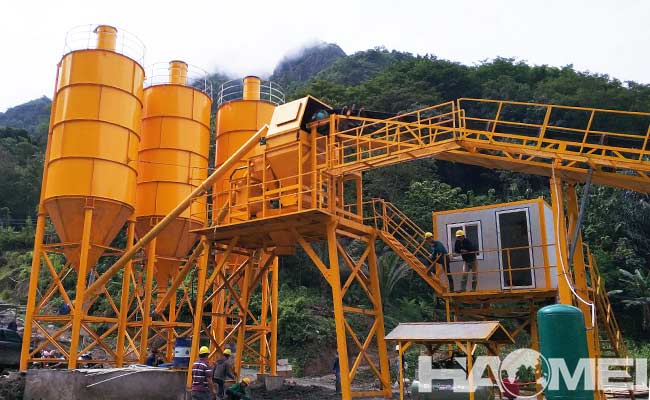Concrete Batch Plant Dust Control
The main sources of dust pollution in mixing plants are the fugitive dust generated by the stacking and transfer of sand and gravel yard, the leakage generated when powder enters the warehouse, and the three categories of dust generated when producing ingredients. For the concrete batch plant dust control in the stockyard, the factory-type closed stockyard is basically used, supplemented by atomization spray measures to reduce dust. The powder silo adopts a combination of active dust collector and safety valve, and adopts a fully enclosed main station, which can effectively solve the dust when the powder enters the silo. Only the concrete batching plant is prone to dust due to powder batching and vibration of the batching station during production, and the batching system is mostly moving parts, with many interfaces, and the powder flow rate is fast, which is more likely to cause dust pollution. Threatening the life and health of the workers in the mixing plant, endanger the safe operation of the mixing plant.

Now, we mainly summarizes the dust generated in the batching process, and provide suitable concrete batch plant dust control.
(1, Aggregate feeding link.
In the production process of concrete, the input of aggregate is an important part of dust generation. Therefore, attention should be paid to the product design process. The dust generated during the feeding process is mainly sand and gravel materials transported from the aggregate silo to the weighing hopper. During the process, the distance between the belt conveyor and the aggregate weighing bucket often has a certain distance. In the process of the aggregate falling into the weighing hopper, the powder components in the aggregate (mainly the stone powder in the stone and the sand powder in the sand).
(2, Powder feeding link.
The powder is mainly composed of cement, additives and other components. The powder itself is easily disturbed by the airflow during the transmission process to generate dust. When the powder is weighed and the aggregate is put into the mixer, it is more affected by the falling of the aggregate. The airflow rises to form dust. . At the same time, when the powder hopper is discharged, since the powder hopper is discharged towards the mixing host, it is easy to form a negative pressure in the gap above the hopper, blowing the powder to flow and generating a large amount of dust.
(3, The negative pressure in the storage bin forms dust.
In the process of unloading the raw materials from the storage bin to the concrete mixing host, the air pressure of the storage bin is low, and it is easy to cause dust during the unloading process. If the filter cloth in the dust removal system is damaged, it is easy to cause dust leakage. Therefore, the dust in the storage bin should be treated accordingly.
For the dust generated by the concrete mixing plant, a centralized dust removal system can be used. The dust removal principle of centralized dust removal is that the centralized dust removal system on the upper end of the hood starts to work when the concrete batching plant starts to enter the production state. Due to the strong suction of the fan in the centralized dust removal system, the airflow in the hood is transferred to the dust removal space in the hood. Another part settles inside the hood. In the process of weighing the powder, the butterfly valve at the lower end of the weighing hopper is closed. Other dust gases in the host and other dust in the bucket will enter the host together. When adding aggregate and powder to the main machine, the dust in the main machine will also enter the dust removal space in the hood, and the remaining part will reach the aggregate pre-storage hopper before the discharge valve is closed.
After such a series of concrete batch plant dust control processes, the three main sources of dust in the mixing process of the concrete batching plant will be effectively suppressed. The dust after centralized treatment can be filtered and discharged into the atmosphere. The dust retained by the dust system will be concentrated in the filter bag of the dust system, and then the dust will be humidified by the spray device to facilitate collection and processing.

